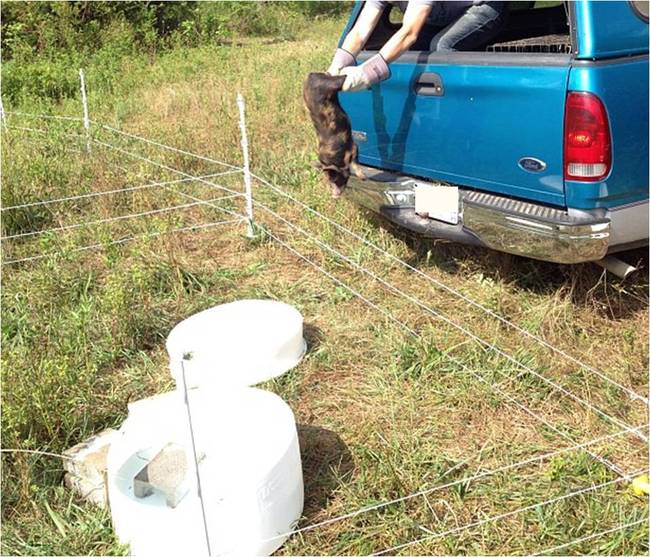 Releasing the Ossabaw pigs into their paddocks
Releasing the Ossabaw pigs into their paddocks
When we started down the road of farming we wanted to raise animals that could survive well on their own. With pigs that’s almost a zero possibility proposition. There aren’t wild pigs out there that you can control on your property and rely on them eating only what your forests, orchards and fields naturally produce. You have to feed them something, or grow food for them. Fortunately, we have the dairy and pigs love the leftover whey from making cheese. Nine out of ten pounds of milk ends up as whey water, one pound ends up as cheese. That's a lot of waste at the average dairy. We aren't your average dairy. Our pigs will consume the whey and turn it into pastured and whey-fed pork. It’s a great combination and is one that dates back hundreds and hundreds of years. Many symbiotic relationships have been lost in the industrial farming world; we plan to bring them back.
However, according to studies we’ve read and farmers we’ve talked to whey can only realistically comprise 30-50% of their diet. Too much whey, like too much of anything, upsets the pigs bodily functions and leads to a soft and mushy meat. Just enough whey leads to a perfectly delicious and mildly sweet pork. So the pigs have to eat something else. Luckily, we have a lot of oak, hickory and walnut trees in our woodlots, so the pigs can harvest the nuts, or "mast", as it’s more correctly referred. Sounds nice, but the trees aren’t always producing nuts, so we have to fill the gap. Part of that will come through other natural forages that we plan to grow for them to harvest, like peas, root crops, corn and other vegetables. The remainder will be supplemented with as little local feed as possible. Luckily, we have a great local feed source and we can also get some from the Mennonites up the road.
Because we want an adaptive pig that can actively root and harvest its own food we needed to get a breed that wasn’t too far removed from its origins. Today’s commercial pigs wouldn’t know what to do with a corn stalk if you grew it in its concrete crate. We also didn’t want pigs that got to be 1,000 pounds or larger. Maybe in the future, but not to start. We don’t have the facilities or the know-how to handle a pig that big, especially if we want to rotate their paddocks through the woodlots.
So we went with the Ossabaw Island Hogs. It's a breed that our friends at Nature’s Harmony raise, so we had a source for breeding stock (not a small hurdle, these little guys are RARE). In fact, they're listed as "Critical" on the American Livestock Breeds Conservancy website. Ossabaw’s are known as a “feral” breed because they are still pretty wild. And by pretty wild I mean very wild. They also produce prized pork, which one day we hope you'll eat.
So on Saturday we picked up our four “weaners”. Two boars and two "gilts" (young females). This means they just came off mom's teats and are being "weaned", thus the "weaner" designation. Ironically, they will later be turned into actual weiners, but not yet. They’re about 20 pounds at a couple months old and they need to get to about 220 before we eat them.
After we loaded them we drove home and they lived in the back of the truck (with a very secure camper shell on it) for a night. We packed ‘em in with hay, water, whey and some kitchen scraps and feed.
 Pigs eating dinner after the drive on Saturday. Oh man they're cute, when you can see 'em!
Pigs eating dinner after the drive on Saturday. Oh man they're cute, when you can see 'em!
Then on Sunday we let them go into their paddocks. Boars in one. Sows in the other. Far enough away that they couldn’t see each other. Each with water, food and whey. Each surrounded by three very hot and very low-to-the-ground electric wires. In fact, each paddock had two electric fences set up. A smaller one within a larger one, just to be “sure” that they wouldn’t get out. After all, they’ll have their food, water and whey all set for them in their beautiful new abode. What else could they want?
I don’t know, but they wanted something and they busted right out! No regard for electric shocking. We had four loose piglets. As my sister phrased it in the caption for the lead-in photo: "Release of the weaners. Promptly followed by escape of the weaners".
And there we were, Scrapple and Sweetbreads on the “porkout”. See you for Part Two.

